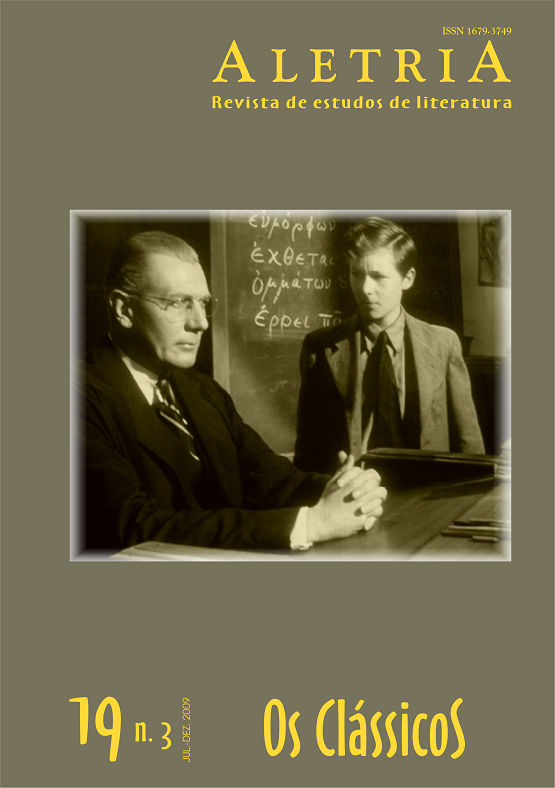A face 'gramatical' de Varrão em De Re Rustica II
DOI:
https://doi.org/10.17851/2317-2096.19.3.89-101Keywords:
Varrão reatino, De re rustica II, Gramática antiga, Varron retain, Grammaire ancienne.Abstract
Resumo: Propomo-nos, neste artigo, discriminar e descrever como Varrão incorporou funcionalmente três tarefas do “gramático” (etimologia, explicação lexical e “anotação)” à composição do livro II de seu De re rustica.
Palavras-chave: Varrão reatino; De re rustica II; Gramática antiga.
Résumé: On se propose, dans cet article, de discriminer et décrire comment Varron a intégré fonctionnellement trois tâches du “grammarien” (l’étymologie, l’explication lexicalle et l’“annotation”) à la composition du deuxième livre de son De re rustica.
Mots-clés: Varron retain; De re rustica II; Grammaire ancienne.
Downloads
References
BARATIN, M.; DESBORDES, F. L’analyse linguistique dans l’antiquité classique. Paris: Klincksieck, 1981. v. I (les théories). 269 p.
CATO; VARRO. On agriculture. 9th. edition, with an English translation by W. D. Hooper and H. B. Ash. Cambridge, Mass./ London: Harvard University Press, 2006. 543 p.
GRIMAL, P. La littérature latine. Paris: Fayard, 1994. 643 p.
LYONS, J. Introdução à linguística teórica. Trad. Rosa Virgínia Mattos e Silva e Hélio Pimentel. São Paulo: Companhia Editora Nacional/ Edusp, 1979. 545p.
MARTIN, R. Recherches sur les agronomes latins et leurs conceptions economiques et sociales. Paris: Les Belles Lettres, 1971. 405 p.
PEREIRA, M. A. Quintiliano gramático: o papel do mestre de gramática na “Institutio oratoria”. São Paulo: Humanitas, 2000. 195 p.
PERUTELLI, A. Il testo come maestro. In: CAVALLO, G.; FEDELI, P.; GIARDINA, A. (Org.). Lo spazio letterario di Roma antica. Roma: Salerno, 1989. v. I, p. 277-310.
PLATON. Cratyle. Texte établi et traduit par L. Méridier. Paris: Les Belles Lettres, 1931. 229 p.
QUINTILIAN. Institutio oratoria. With an English translation by H. E. Butler. Cambridge, Mass./ London: Harvard University Press, 1922. v. IV, 556 p.
ROBERT, J.-N. La vie à la campagne dans l’antiquité romaine. Paris: Les Belles Lettres, 1985. 320 p.
ROBINS, R. H. Pequena história da linguística. Trad. Luiz M. M. de Barros. Rio de Janeiro: Ao Livro Técnico, 1983. 216 p.
SAINT-DENIS, E. de. Syntaxe du latin parlé dans les “Res Rusticae” de Varron. Revue de Philologie, Paris, année et tome XXI, p. 141-162, 1947.
SKYDSGAARD, J. E. Varro the Scholar: Studies in the First Book of Varro’s “De re rustica”. Copenhagen: Einar Munksgaard, 1968. 133 p.
TREVIZAM, M. Das especulações “etimológicas” antigas: as contribuições de Platão e Varrão. Classica, São Paulo, v. 15/ 16, n. 15/ 16, p. 179-188, 2002/ 2003.
TREVIZAM, M. Heterogeneidade enunciativa e discursiva nas “Geórgicas” de Virgílio. In: BARBOSA, M. V.; ZOPPI-FONTANA, M. G. (Org.). Caderno de qualificações. Campinas: UNICAMP, n. I, p. 185-198, 2005.
TREVIZAM, M. Linguagem e interpretação na literatura agrária latina. 2006. 526 f. Tese (Doutorado) –Programa de Pós-Graduação em Linguística do IEL-UNICAMP, Campinas, 2006.
VARRÓN. De lingua Latina. Edición bilíngue. Introducción, traducción y notas de M.- A. M. Casquero. Barcelona/ Madrid: Anthropos/ Ministerio de la Educación y Ciencia, 1990. 574 p.
VIRGIL. Georgics. 3rd. edition by R. F. Thomas. Cambridge: University Press, 1994. v. I, 276 p.
Downloads
Published
How to Cite
Issue
Section
License
Copyright (c) 2009 Matheus Trevizam (Autor)

This work is licensed under a Creative Commons Attribution 4.0 International License.
Authors who publish with this journal agree to the following terms:Authors retain copyright and grant the journal right of first publication with the work simultaneously licensed under a Creative Commons Attribution Non-Commercial No Derivatives License that allows others to share the work with an acknowledgement of the work's authorship and initial publication in this journal.Authors are able to enter into separate, additional contractual arrangements for the non-exclusive distribution of the journal's published version of the work (e.g., post it to an institutional repository or publish it in a book), with an acknowledgement of its initial publication in this journal.Authors are permitted and encouraged to post their work online (e.g., in institutional repositories or on their website) prior to and during the submission process, as it can lead to productive exchanges, as well as earlier and greater citation of published work (See The Effect of Open Access).





